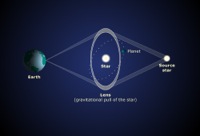Difference between revisions of "Gravitational microlensing"
m (moved Microlensing to Gravitational microlensing) |
m (Text replacement - "http://" to "https://") |
||
| (One intermediate revision by one other user not shown) | |||
| Line 1: | Line 1: | ||
| − | [[File:lighterstill.jpg]] | + | [[File:lighterstill.jpg]][[File:Microlensing.jpg|right|frame]] |
| − | '''Gravitational microlensing''' is an [[astronomical]] [[phenomenon]] due to the [ | + | '''Gravitational microlensing''' is an [[astronomical]] [[phenomenon]] due to the [https://en.wikipedia.org/wiki/Gravitational_lens gravitational lens] effect. It can be used to detect objects ranging from the [[mass]] of a [[planet]] to the mass of a [[star]], regardless of the light they emit. Typically, astronomers can only detect bright objects that emit lots of light (stars) or large objects that block background light (clouds of gas and dust). These objects make up only a tiny [[fraction]] of the mass of a galaxy. Microlensing allows the [[study]] of objects that emit little or no light. |
| − | When a distant [[star]] or [ | + | When a distant [[star]] or [https://en.wikipedia.org/wiki/Quasar quasar] gets sufficiently aligned with a massive compact foreground object, the bending of [[light]] due to its gravitational field, as discussed by [[Einstein]] in 1915, leads to two [[distorted]] unresolved images resulting in an observable magnification. The time-scale of the transient brightening depends on the mass of the foreground object as well as on the [[relative]] proper motion between the background 'source' and the foreground 'lens' object. |
| − | Since microlensing [[observations]] do not rely on [[radiation]] received from the [[lens]] object, this effect therefore allows astronomers to study massive objects no matter how faint. It is thus an [[ideal]] [[technique]] to study the galactic population of such faint or dark objects as [ | + | Since microlensing [[observations]] do not rely on [[radiation]] received from the [[lens]] object, this effect therefore allows astronomers to study massive objects no matter how faint. It is thus an [[ideal]] [[technique]] to study the galactic population of such faint or dark objects as [https://en.wikipedia.org/wiki/Brown_dwarfs brown dwarfs], [https://en.wikipedia.org/wiki/Red_dwarfs red dwarfs], [[planets]], [https://en.wikipedia.org/wiki/White_dwarfs white dwarfs], [https://en.wikipedia.org/wiki/Neutron_stars neutron stars], [[black holes]], and [https://en.wikipedia.org/wiki/Massive_compact_halo_object Massive Compact Halo Objects]. Moreover, the microlensing effect is wavelength-independent, allowing study of source objects that emit any kind of [[electromagnetic]] [[radiation]]. |
| − | Microlensing by an isolated object was first detected in 1989. Since then, microlensing has been used to constrain the nature of the [ | + | Microlensing by an isolated object was first detected in 1989. Since then, microlensing has been used to constrain the nature of the [https://en.wikipedia.org/wiki/Dark_matter dark matter], detect [https://en.wikipedia.org/wiki/Extrasolar_planets extrasolar planets], study [https://en.wikipedia.org/wiki/Limb_darkening limb darkening] in distant stars, constrain the [https://en.wikipedia.org/wiki/Binary_star binary star] population, and constrain the [[structure]] of the [[Milky Way]]'s disk. Microlensing has also been proposed as a means to find dark objects like brown dwarfs and black holes, study starspots, measure stellar rotation, and probe [https://en.wikipedia.org/wiki/Quasars quasars] including their [https://en.wikipedia.org/wiki/Accretion_disks accretion disks].[https://en.wikipedia.org/wiki/Microlensing] |
[[Category: Astronomy]] | [[Category: Astronomy]] | ||
Latest revision as of 00:11, 13 December 2020
Gravitational microlensing is an astronomical phenomenon due to the gravitational lens effect. It can be used to detect objects ranging from the mass of a planet to the mass of a star, regardless of the light they emit. Typically, astronomers can only detect bright objects that emit lots of light (stars) or large objects that block background light (clouds of gas and dust). These objects make up only a tiny fraction of the mass of a galaxy. Microlensing allows the study of objects that emit little or no light.
When a distant star or quasar gets sufficiently aligned with a massive compact foreground object, the bending of light due to its gravitational field, as discussed by Einstein in 1915, leads to two distorted unresolved images resulting in an observable magnification. The time-scale of the transient brightening depends on the mass of the foreground object as well as on the relative proper motion between the background 'source' and the foreground 'lens' object.
Since microlensing observations do not rely on radiation received from the lens object, this effect therefore allows astronomers to study massive objects no matter how faint. It is thus an ideal technique to study the galactic population of such faint or dark objects as brown dwarfs, red dwarfs, planets, white dwarfs, neutron stars, black holes, and Massive Compact Halo Objects. Moreover, the microlensing effect is wavelength-independent, allowing study of source objects that emit any kind of electromagnetic radiation.
Microlensing by an isolated object was first detected in 1989. Since then, microlensing has been used to constrain the nature of the dark matter, detect extrasolar planets, study limb darkening in distant stars, constrain the binary star population, and constrain the structure of the Milky Way's disk. Microlensing has also been proposed as a means to find dark objects like brown dwarfs and black holes, study starspots, measure stellar rotation, and probe quasars including their accretion disks.[1]
